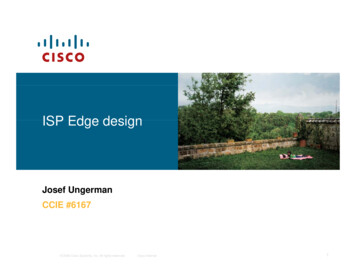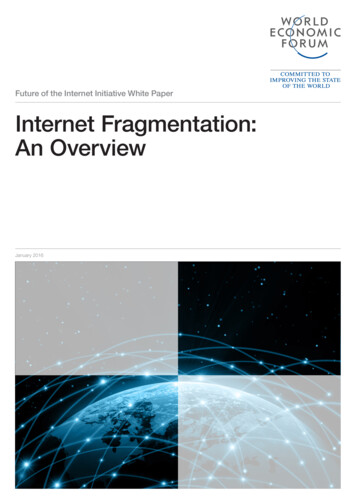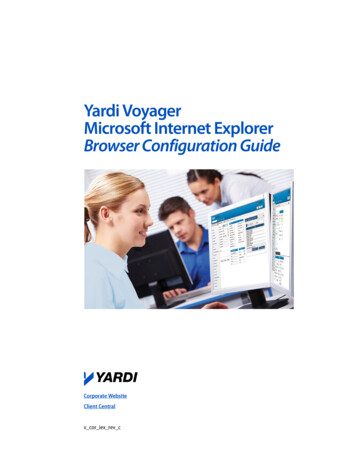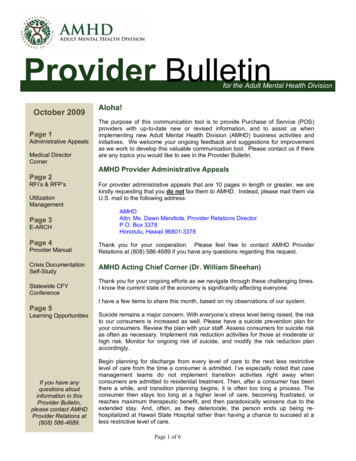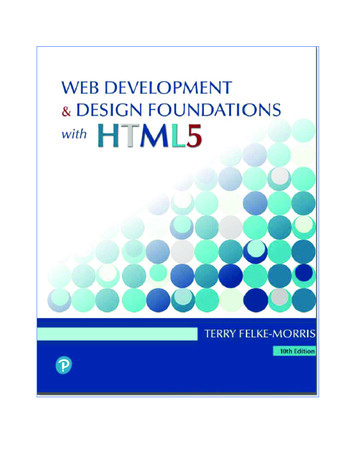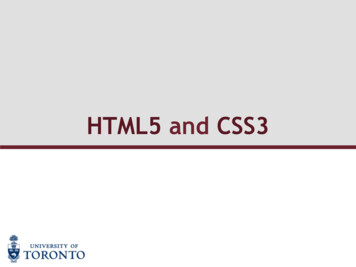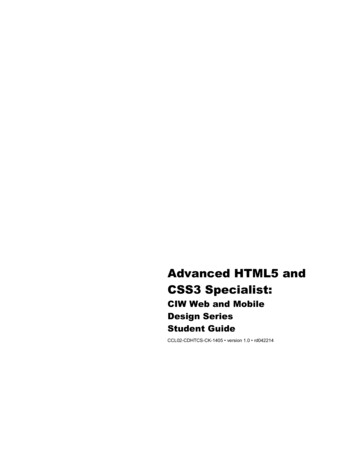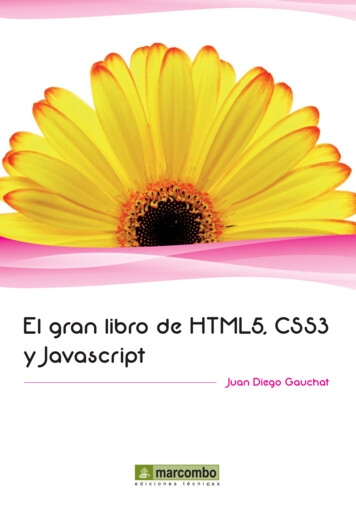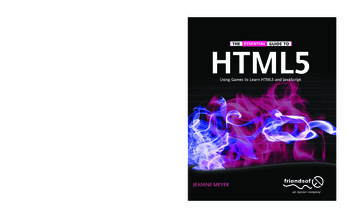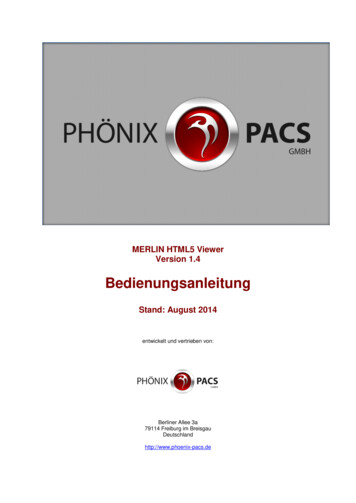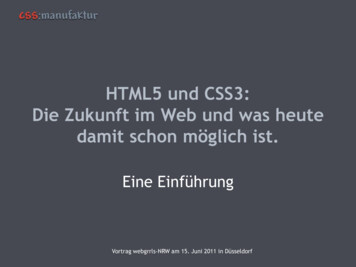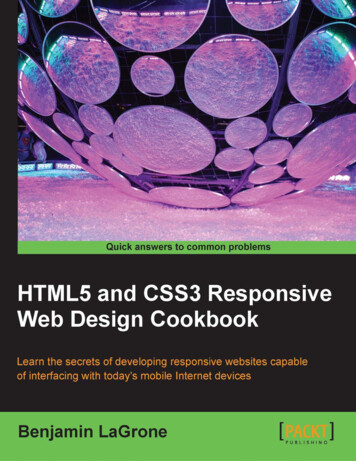![[MS-HTML5]: Microsoft Edge / Internet Explorer HTML5 .](/img/13/ms-html5-170314.jpg)
Transcription
[MS-HTML5]:Microsoft Edge / Internet Explorer HTML5 StandardsSupport DocumentIntellectual Property Rights Notice for Open Specifications Documentation Technical Documentation. Microsoft publishes Open Specifications documentation (“thisdocumentation”) for protocols, file formats, data portability, computer languages, and standardssupport. Additionally, overview documents cover inter-protocol relationships and interactions. Copyrights. This documentation is covered by Microsoft copyrights. Regardless of any otherterms that are contained in the terms of use for the Microsoft website that hosts thisdocumentation, you can make copies of it in order to develop implementations of the technologiesthat are described in this documentation and can distribute portions of it in your implementationsthat use these technologies or in your documentation as necessary to properly document theimplementation. You can also distribute in your implementation, with or without modification, anyschemas, IDLs, or code samples that are included in the documentation. This permission alsoapplies to any documents that are referenced in the Open Specifications documentation. No Trade Secrets. Microsoft does not claim any trade secret rights in this documentation. Patents. Microsoft has patents that might cover your implementations of the technologiesdescribed in the Open Specifications documentation. Neither this notice nor Microsoft's delivery ofthis documentation grants any licenses under those patents or any other Microsoft patents.However, a given Open Specifications document might be covered by the Microsoft OpenSpecifications Promise or the Microsoft Community Promise. If you would prefer a written license,or if the technologies described in this documentation are not covered by the Open SpecificationsPromise or Community Promise, as applicable, patent licenses are available by contactingiplg@microsoft.com. Trademarks. The names of companies and products contained in this documentation might becovered by trademarks or similar intellectual property rights. This notice does not grant anylicenses under those rights. For a list of Microsoft trademarks, visitwww.microsoft.com/trademarks. Fictitious Names. The example companies, organizations, products, domain names, emailaddresses, logos, people, places, and events that are depicted in this documentation are fictitious.No association with any real company, organization, product, domain name, email address, logo,person, place, or event is intended or should be inferred.Reservation of Rights. All other rights are reserved, and this notice does not grant any rights otherthan as specifically described above, whether by implication, estoppel, or otherwise.Tools. The Open Specifications documentation does not require the use of Microsoft programmingtools or programming environments in order for you to develop an implementation. If you have accessto Microsoft programming tools and environments, you are free to take advantage of them. CertainOpen Specifications documents are intended for use in conjunction with publicly available standardsspecifications and network programming art and, as such, assume that the reader either is familiarwith the aforementioned material or has immediate access to it.1 / 173[MS-HTML5] - v20170314Microsoft Edge / Internet Explorer HTML5 Standards Support DocumentCopyright 2017 Microsoft CorporationRelease: March 14, 2017
Revision 7/20151.0NewReleased new document7/7/20151.1MinorClarified the meaning of the technical content.11/2/20151.2MinorClarified the meaning of the technical content.3/22/20161.3MinorClarified the meaning of the technical content.7/19/20161.4MinorClarified the meaning of the technical content.11/2/20161.4NoneNo changes to the meaning, language, or formatting of thetechnical content.3/14/20171.4NoneNo changes to the meaning, language, or formatting of thetechnical content.2 / 173[MS-HTML5] - v20170314Microsoft Edge / Internet Explorer HTML5 Standards Support DocumentCopyright 2017 Microsoft CorporationRelease: March 14, 2017
Table of Contents1Introduction . 81.1Glossary . 81.2References . 81.2.1Normative References . 81.2.2Informative References . 81.3Microsoft Implementations . 81.4Standards Support Requirements . 91.5Notation. 102Standards Support Statements . 112.1Normative Variations . 112.1.1[HTML5] Section 2.4.1 Common parser idioms . 112.1.2[HTML5] Section 2.4.4.3 Floating-point numbers . 112.1.3[HTML5] Section 2.5.3 Dynamic changes to base URLs . 132.1.4[HTML5] Section 2.7.2.1 HTMLAllCollection . 132.1.5[HTML5] Section 2.7.2.2 HTMLFormControlsCollection . 152.1.6[HTML5] Section 2.7.2.3 HTMLOptionsCollection . 152.1.7[HTML5] Section 2.7.6 Callbacks . 162.1.8[HTML5] Section 3.1.1 The Document object. 162.1.9[HTML5] Section 3.1.2 Resource metadata management . 172.1.10[HTML5] Section 3.2.2 Elements in the DOM . 172.1.11[HTML5] Section 3.2.4.1.7 Interactive content . 182.1.12[HTML5] Section 3.2.5.4 The translate attribute . 182.1.13[HTML5] Section 3.2.5.6 The dir attribute . 182.1.14[HTML5] Section 3.2.5.9 Embedding custom non-visible data with the data-*attributes . 192.1.15[HTML5] Section 4.2.2 The title element . 192.1.16[HTML5] Section 4.2.3 The base element. 202.1.17[HTML5] Section 4.2.4 The link element . 212.1.18[HTML5] Section 4.2.6 The style element . 222.1.19[HTML5] Section 4.3.1 The body element . 222.1.20[HTML5] Section 4.3.10.1 Creating an outline . 232.1.21[HTML5] Section 4.4.5 The ol element . 242.1.22[HTML5] Section 4.5.1 The a element . 242.1.23[HTML5] Section 4.5.10 The data element . 252.1.24[HTML5] Section 4.5.11 The time element . 262.1.25[HTML5] Section 4.5.22 The rb element . 262.1.26[HTML5] Section 4.5.24 The rtc element. 262.1.27[HTML5] Section 4.5.26 The bdi element . 272.1.28[HTML5] Section 4.7.1 The img element . 272.1.29[HTML5] Section 4.7.2 The iframe element . 272.1.30[HTML5] Section 4.7.3 The embed element . 282.1.31[HTML5] Section 4.7.4 The object element . 282.1.32[HTML5] Section 4.7.6 The video element . 292.1.33[HTML5] Section 4.7.8 The source element . 292.1.34[HTML5] Section 4.7.9 The track element . 292.1.35[HTML5] Section 4.7.10 Media elements . 302.1.36[HTML5] Section 4.7.10.1 Error codes . 332.1.37[HTML5] Section 4.7.10.2 Location of the media resource . 342.1.38[HTML5] Section 4.7.10.5 Loading the media resource . 342.1.39[HTML5] Section 4.7.10.6 Offsets into the media resource . 362.1.40[HTML5] Section 4.7.10.9 Seeking . 372.1.41[HTML5] Section 4.7.10.10.1 AudioTrackList and VideoTrackList objects . 372.1.42[HTML5] Section 4.7.10.10.2 Selecting specific audio and video tracks declaratively403 / 173[MS-HTML5] - v20170314Microsoft Edge / Internet Explorer HTML5 Standards Support DocumentCopyright 2017 Microsoft CorporationRelease: March 14, 2017
2.1.932.1.942.1.952.1.962.1.97[HTML5] Section 4.7.10.11 Synchronizing multiple media elements . 40[HTML5] Section 4.7.10.12.1 Text track model . 40[HTML5] Section 4.7.10.12.2 Sourcing in-band text tracks . 41[HTML5] Section 4.7.10.12.3 Sourcing out-of-band text tracks . 43[HTML5] Section 4.7.10.12.5 Text track API. 45[HTML5] Section 4.7.10.12.7 Event definitions . 49[HTML5] Section 4.7.10.14 Time ranges . 50[HTML5] Section 4.7.10.15 Event definitions . 50[HTML5] Section 4.7.11 The map element . 50[HTML5] Section 4.7.12 The area element . 51[HTML5] Section 4.7.13.2 Processing model . 54[HTML5] Section 4.7.14 MathML . 55[HTML5] Section 4.8.3 Downloading resources . 55[HTML5] Section 4.8.4.9 Link type "prefetch" . 56[HTML5] Section 4.9.1 The table element . 56[HTML5] Section 4.9.5 The tbody element . 57[HTML5] Section 4.9.8 The tr element . 57[HTML5] Section 4.9.10 The th element . 58[HTML5] Section 4.9.11 Attributes common to td and th elements . 58[HTML5] Section 4.9.12.2 Forming relationships between data cells and header cells59[HTML5] Section 4.10.3 The form element . 59[HTML5] Section 4.10.4 The label element . 60[HTML5] Section 4.10.5 The input element . 60[HTML5] Section 4.10.5.1.1 Hidden state (type hidden) . 62[HTML5] Section 4.10.5.1.4 URL state (type url) . 63[HTML5] Section 4.10.5.1.5 E-mail state (type email) . 63[HTML5] Section 4.10.5.1.7 Date state (type date). 64[HTML5] Section 4.10.5.1.8 Time state (type time) . 65[HTML5] Section 4.10.5.1.9 Number state (type number) . 65[HTML5] Section 4.10.5.1.10 Range state (type range) . 65[HTML5] Section 4.10.5.1.11 Color state (type color) . 66[HTML5] Section 4.10.5.1.12 Checkbox state (type checkbox) . 66[HTML5] Section 4.10.5.1.13 Radio Button state (type radio) . 67[HTML5] Section 4.10.5.1.14 File Upload state (type file) . 69[HTML5] Section 4.10.5.1.17 Reset Button state (type reset) . 69[HTML5] Section 4.10.6 The button element . 70[HTML5] Section 4.10.7 The select element . 70[HTML5] Section 4.10.10 The option element . 72[HTML5] Section 4.10.11 The textarea element . 72[HTML5] Section 4.10.12 The keygen element . 74[HTML5] Section 4.10.13 The output element . 74[HTML5] Section 4.10.14 The progress element . 74[HTML5] Section 4.10.15 The meter element . 74[HTML5] Section 4.10.16 The fieldset element . 75[HTML5] Section 4.10.18.3 Association of controls and forms . 76[HTML5] Section 4.10.19.2 Submitting element directionality: the dirname attribute76[HTML5] Section 4.10.19.4 Setting minimum input length requirements: theminlength attribute . 76[HTML5] Section 4.10.19.7 Autofocusing a form control: the autofocus attribute 77[HTML5] Section 4.10.20 APIs for the text field selections . 77[HTML5] Section 4.10.21.1 Definitions . 78[HTML5] Section 4.10.21.2 Constraint validation . 78[HTML5] Section 4.10.21.3 The constraint validation API . 79[HTML5] Section 4.10.22.5 Selecting a form submission encoding . 80[HTML5] Section 4.10.22.6 URL-encoded form data . 81[HTML5] Section 4.10.22.7 Multipart form data . 814 / 173[MS-HTML5] - v20170314Microsoft Edge / Internet Explorer HTML5 Standards Support DocumentCopyright 2017 Microsoft CorporationRelease: March 14, 2017
1.1482.1.1492.1.1502.1.151[HTML5] Section 4.10.22.8 Plain text form data . 82[HTML5] Section 4.11.1 The script element . 82[HTML5] Section 4.11.1.1 Scripting languages . 84[HTML5] Section 4.11.3 The template element . 85[HTML5] Section 4.11.4 The canvas element . 85[HTML5] Section 4.11.4.2 Serializing bitmaps to a file . 86[HTML5] Section 4.14.2 Pseudo-classes. 86[HTML5] Section 5.1 Browsing contexts . 91[HTML5] Section 5.1.1.1 Navigating nested browsing contexts in the DOM . 93[HTML5] Section 5.1.6 Browsing context names . 94[HTML5] Section 5.2 The Window object . 95[HTML5] Section 5.2.1 Security . 96[HTML5] Section 5.2.2 APIs for creating and navigating browsing contexts by name97[HTML5] Section 5.2.3 Accessing other browsing contexts . 98[HTML5] Section 5.2.4 Named access on the Window object . 98[HTML5] Section 5.3.1 Relaxing the same-origin restriction . 99[HTML5] Section 5.5.3.1 Security . 99[HTML5] Section 5.6.6 Page load processing model for media .100[HTML5] Section 5.6.7 Page load processing model for content that uses plugins100[HTML5] Section 5.6.10.1 Event definitions.100[HTML5] Section 5.6.11 Unloading documents.102[HTML5] Section 5.7.3.3 Parsing cache manifests .102[HTML5] Section 6.1.3.6 Runtime script errors .102[HTML5] Section 6.1.3.6.2 The ErrorEvent interface .103[HTML5] Section 6.1.5.1 Event handlers .103[HTML5] Section 6.1.5.2 Event handlers on elements, Document objects, andWindow objects .105[HTML5] Section 6.3.1 Opening the input stream .108[HTML5] Section 6.3.2 Closing the input stream .109[HTML5] Section 6.3.3 document.write() .109[HTML5] Section 6.6.1 The Navigator object .110[HTML5] Section 6.6.1.1 Client identification .110[HTML5] Section 6.6.1.2 Language preferences .111[HTML5] Section 6.6.1.3 Custom scheme and content handlers .112[HTML5] Section 6.6.1.4 Manually releasing the storage mutex .112[HTML5] Section 6.6.1.5 Plugins .113[HTML5] Section 7.4.1 Sequential focus navigation and the tabindex attribute .114[HTML5] Section 7.6.1 Making document regions editable: The contenteditablecontent attribute .114[HTML5] Section 7.6.2 Making entire documents editable: The designMode IDLattribute .115[HTML5] Section 7.6.5 Spelling and grammar checking .115[HTML5] Section 8.2 Parsing HTML documents .115[HTML5] Section 8.2.3.1 The insertion mode .116[HTML5] Section 8.2.3.2 The stack of open elements .117[HTML5] Section 8.2.4.38 Attribute value (double-quoted) state .117[HTML5] Section 8.2.4.39 Attribute value (single-quoted) state .117[HTML5] Section 8.2.4.45 Markup declaration open state .118[HTML5] Section 8.2.4.48 Comment state .118[HTML5] Section 8.2.5 Tree construction .118[HTML5] Section 8.2.5.3 Closing elements that have implied end tags .119[HTML5] Section 8.2.5.4.7 The "in body" insertion mode .119[HTML5] Section 8.2.5.4.9 The "in table" insertion mode .120[HTML5] Section 8.2.5.4.11 The "in caption" insertion mode .120[HTML5] Section 8.2.5.4.17 The "in select in table" insertion mode .121[HTML5] Section 8.2.5.4.18 The "in template" insertion mode .121[HTML5] Section 8.2.5.5 The rules for parsing tokens in foreign content .1225 / 173[MS-HTML5] - v20170314Microsoft Edge / Internet Explorer HTML5 Standards Support DocumentCopyright 2017 Microsoft CorporationRelease: March 14, 2017
2.1.152 [HTML5] Section 10.3.1 Hidden elements .1222.1.153 [HTML5] Section 10.3.3 Flow content .1232.1.154 [HTML5] Section 10.3.4 Phrasing content .1242.1.155 [HTML5] Section 10.3.5 Bidirectional text .1282.1.156 [HTML5] Section 10.3.6 Quotes .1282.1.157 [HTML5] Section 10.3.7 Sections and headings .1292.1.158 [HTML5] Section 10.3.8 Lists .1292.1.159 [HTML5] Section 10.3.9 Tables .1302.1.160 [HTML5] Section 10.3.11 Form controls .1342.1.161 [HTML5] Section 10.3.12 The hr element .1352.1.162 [HTML5] Section 10.3.13 The fieldset and legend elements .1352.1.163 [HTML5] Section 10.4.1 Embedded content.1362.1.164 [HTML5] Section 10.4.2 Images .1362.1.165 [HTML5] Section 10.4.3 Attributes for embedded content and images .1372.1.166 [HTML5] Section 10.4.4 Image maps .1382.1.167 [HTML5] Section 10.5 Bindings .1382.1.168 [HTML5] Section 10.5.11 The meter element .1382.1.169 [HTML5] Section 11.3.4 Other elements, attributes and APIs .1392.2Clarifications .1422.2.1[HTML5] Section 2.2.1 Conformance classes .1422.2.2[HTML5] Section 2.2.2 Dependencies .1432.2.3[HTML5] Section 2.6.3 Encrypted HTTP and related security concerns .1432.2.4[HTML5] Section 2.6.7 CORS-enabled fetch .1432.2.5[HTML5] Section 3.2.5.2 The title attribute .1442.2.6[HTML5] Section 3.2.5.3 The lang and xml:lang attributes .1442.2.7[HTML5] Section 4.2.4 The link element .1442.2.8[HTML5] Section 4.2.5.1 Standard metadata names .1452.2.9[HTML5] Section 4.2.5.3 Pragma directives .1462.2.10[HTML5] Section 4.3.9 The address element .1462.2.11[HTML5] Section 4.4.4 The blockquote element .1472.2.12[HTML5] Section 4.4.7 The li element.1472.2.13[HTML5] Section 4.6.3 Attributes common to ins and del elements .1482.2.14[HTML5] Section 4.7.1 The img element .1482.2.15[HTML5] Section 4.7.3 The embed element .1492.2.16[HTML5] Section 4.7.6 The video element .1492.2.17[HTML5] Section 4.7.10.5 Loading the media resource .1512.2.18[HTML5] Section 4.7.10.8 Playing the media resource .1522.2.19[HTML5] Section 4.7.10.12.6 Text tracks describing chapters .1522.2.20[HTML5] Section 4.7.10.13 User interface .1522.2.21[HTML5] Section 4.8 Links .1532.2.22[HTML5] Section 4.8.1 Links created by a and area elements .1532.2.23[HTML5] Section 4.10.5.1.5 E-mail state (type email) .1542.2.24[HTML5] Section 4.10.5.1.14 File Upload state (type file) .1542.2.25[HTML5] Section 4.10.19.3 Limiting user input length: the maxlength attribute .1552.2.26[HTML5] Section 4.10.19.8 Autofilling form controls: the autocomplete attribute1552.2.27[HTML5] Section 4.10.21.2 Constraint validation .1552.2.28[HTML5] Section 4.10.22.7 Multipart form data .1562.2.29[HTML5] Section 4.11.4.2 Serializing bitmaps to a file .1562.2.30[HTML5] Section 5.1.3 Secondary browsing contexts .1572.2.31[HTML5] Section 5.1.6 Browsing context names .1572.2.32[HTML5] Section 5.2.2 APIs for creating and navigating browsing contexts by name1582.2.33[HTML5] Section 5.5.1 The session history of browsing contexts .1582.2.34[HTML5] Section 5.5.2 The History interface .1592.2.35[HTML5] Section 5.5.3 The Location interface .1592.2.36[HTML5] Section 5.6.1 Navigating across documents .1592.2.37[HTML5] Section 5.6.3 Page load processing model for XML files .1602.2.38[HTML5] Section 5.6.4 Page load processing model for text files .1606 / 173[MS-HTML5] - v20170314Microsoft Edge / Internet Explorer HTML5 Standards Support DocumentCopyright 2017 Microsoft CorporationRelease: March 14, 2017
2.2.39[HTML5] Section 5.6.6 Page load processing model for media .1602.2.40[HTML5] Section 5.6.10 History traversal .1612.2.41[HTML5] Section 5.6.11 Unloading documents.1612.2.42[HTML5] Section 5.6.12 Aborting a document load.1622.2.43[HTML5] Section 5.7.4 Downloading or updating an application cache .1622.2.44[HTML5] Section 5.7.5 The application cache selection algorithm .1622.2.45[HTML5] Section 5.7.8 Disk space.1632.2.46[HTML5] Section 6.1.2 Enabling and disabling scripting .1632.2.47[HTML5] Section 6.1.3.4 Creating scripts .1632.2.48[HTML5] Section 6.1.3.5 Killing scripts .1642.2.49[HTML5] Section 6.1.3.6.1 Runtime script errors in documents .1642.2.50[HTML5] Section 6.1.5.1 Event handlers .1652.2.51[HTML5] Section 6.5.2 Printing .1652.2.52[HTML5] Section 7.1 The hidden attribute .1662.2.53[HTML5] Section 7.2 Inert subtrees .1662.2.54[HTML5] Section 7.4.2 Focus management .1672.2.55[HTML5] Section 7.4.4 Element-level focus APIs .1672.2.56[HTML5] Section 7.5.3 Processing model .1672.2.57[HTML5] Section 7.6.5 Spelling and grammar checking .1682.2.58[HTML5] Section 8.2 Parsing HTML documents .1692.2.59[HTML5] Section 8.2.7 Coercing an HTML DOM into an infoset.1692.2.60[HTML5] Section 9.3 Serializing XHTML fragments .1702.2.61[HTML5] Section 11.3.4 Other elements, attributes and APIs .1702.3Error Handling .1712.4Security .1713Change Tracking . 1724Index . 1737 / 173[MS-HTML5] - v20170314Microsoft Edge / Internet Explorer HTML5 Standards Support DocumentCopyright 2017 Microsoft CorporationRelea
1 / 173 [MS-HTML5] - v20170314 Microsoft Edge / Internet Explorer HTML5 Standards Support Document Copyr
